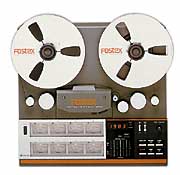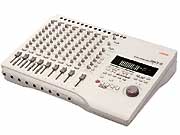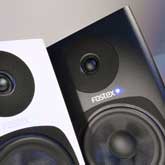Fostex
Corporate Information
Fostex
Corporate History
The Fostex Company was founded in July 1973 by Foster Electric Co.,Ltd. (founded 1949), one of the world's largest developers of OEM speaker and transducer products, employing over 50,000 people in nine countries/territories. Foster Electric Co.,Ltd. is listed on the Tokyo Stock Exchange.
It Starts With Speaker Components
Fostex was established to brand high quality speaker components from Foster and sell them direct to consumers and dealers in the Japanese marketplace. This area of the speaker component business is still something unique to Japan where there continues to be a high number of individuals designing and building their own speaker units at home, some for sale but many just for personal use. Indeed even today speaker component business still represents a major part of Fostex's monthly domestic income although sales are slowly enjoying a renaissance in other territories.
Fostex speaker components initially won acclaim because they were an early developer of RP (Regular Phase) technology which provides for a very clear sound with high sensitivity and wide dynamic range. Today RP technology is well known worldwide not just for speakers but also microphones and headphones, with the Fostex T20RP being one of the most popular studio monitoring headphones in the United States.
In 1978 Fostex started to developed speakers units for professional use and with these products Fostex began to export worldwide causing the brand to became very well known with both hi-fi and professional manufacturers and users. The world's best selling small powered monitor speaker for broadcast and professional use continues to be the Fostex 6301B, still going strong after twenty years.
Through utilising Foster's China facility, following remarkable success in the Japanese market of the NF-1A and NF01A in 2000, which feature patented Hyperbolic Paraboloid (HP) diaphragm engineering, Fostex released the PM-1 speaker in 2002 which has now grown to be a range of three models including the PM-.5 and PM-2, offering budget conscious studios and musicians excellent audio monitoring at excellent price points.
Entry to Multitracking
 In 1981, joined by a new band of engineers, Fostex decided to enter the professional recording industry which was then on the verge of spurning the 'home recording' category. The company started with three reel-to-reel recorders, the A-2, A-4 and by far the most innovative and popular, the A-8 which was the first machine to offer eight tracks on just 1/4" tape. Along with the Model 350 mixer and Model 250 four-track cassette multitracker, Fostex were truly a home recording pioneer.
In 1981, joined by a new band of engineers, Fostex decided to enter the professional recording industry which was then on the verge of spurning the 'home recording' category. The company started with three reel-to-reel recorders, the A-2, A-4 and by far the most innovative and popular, the A-8 which was the first machine to offer eight tracks on just 1/4" tape. Along with the Model 350 mixer and Model 250 four-track cassette multitracker, Fostex were truly a home recording pioneer.
The year also saw Fostex begin its worldwide expansion with the establishment of its first subsidiary, the Fostex Corporation of America in Los Angeles.
Developments in Multitrack Recording
Innovations continued to come at a fast pace from the Fostex development team. In 1983 the X-15 was the first cassette-based four track that was truly portable – it ran on batteries. The size, weight and functionality quickly gained it the 'musicians note pad' nickname and its epitaph is that to this day it remains the No 1 best selling four track the World has ever seen.
 During the same year the B-16 was born, this time being the first machine to provide for 16 tracks on just _" tape and the first of its kind to offer Dolby C noise reduction. The B-16 was so successful that Ampex complained that they couldn't produce _" tape fast enough in order to meet demand! The B-16 was followed in later years by the E-16 (1986) and G-16S (1990) – the first reel-to-reel to have Dolby S noise reduction, a simplified version of the professional SR type standard.
During the same year the B-16 was born, this time being the first machine to provide for 16 tracks on just _" tape and the first of its kind to offer Dolby C noise reduction. The B-16 was so successful that Ampex complained that they couldn't produce _" tape fast enough in order to meet demand! The B-16 was followed in later years by the E-16 (1986) and G-16S (1990) – the first reel-to-reel to have Dolby S noise reduction, a simplified version of the professional SR type standard.
The final model in this prestigious reign of analogue multitrack machines was the G-24S. Once again the format was squeezed to new levels of tolerance as Fostex succeeded in putting 24 tracks onto 1" tape. This machine represented the pinnacle of what could be achieved including a removable front panel remote control and meter bridge; built-in SMTPE/Midi synchronisation; and amazing levels of recording quality. Often the machine would find its way from a producer's home studio to the commercial facility that they were mixing in as it was felt the quality was high enough not to require a format transfer.
The Move to Digial
Sadly some would say, the demise of analogue tape-based products was inevitable as the digital revolution progressed. Fostex joined forces with Alesis and produced the RD-8 which offered professional facilities on the ADAT platform, but the main innovations came about by combining Fostex's knowledge of multitracking and their own in-house hard disc technology developments.
 The world's first 'digital multitracker' arrived in 1995 in the form of the Fostex DMT-8. This eight track digital recorder was packaged to appear very similar to an analogue multitracker, just without a physical tape. It worked very well: the DMT-8 enjoyed tremendous success, especially with musicians such as guitarists who at the time would never have considered recording digitally as that would have meant having to use a computer. The DMT-8 spurned a whole family of digital multitracker-style products including the DMT-8VL; FD-4 and FD-8 'media independent' multitrackers allowing the user to record not only to hard disc but also Zip and SyQuest removable drives; to the now current MR16HD and MR-8HD models which include built-in digital effects with CD-burning and what is probably the most cost-effective 8 track recorder on the market, the MR-8 – recording to Compact Flash cards and benefiting from battery power, Fostex have finally been able to provide the market with a truly digital replacement to the analogue X-15 of so many years ago.
The world's first 'digital multitracker' arrived in 1995 in the form of the Fostex DMT-8. This eight track digital recorder was packaged to appear very similar to an analogue multitracker, just without a physical tape. It worked very well: the DMT-8 enjoyed tremendous success, especially with musicians such as guitarists who at the time would never have considered recording digitally as that would have meant having to use a computer. The DMT-8 spurned a whole family of digital multitracker-style products including the DMT-8VL; FD-4 and FD-8 'media independent' multitrackers allowing the user to record not only to hard disc but also Zip and SyQuest removable drives; to the now current MR16HD and MR-8HD models which include built-in digital effects with CD-burning and what is probably the most cost-effective 8 track recorder on the market, the MR-8 – recording to Compact Flash cards and benefiting from battery power, Fostex have finally been able to provide the market with a truly digital replacement to the analogue X-15 of so many years ago.
As well as successfully replacing the multitracker concept with digital, Fostex also followed on from their reel-to-reel success with stationary rack-mounting digital recorders. Starting out with the D-80 in 1996, Fostex offered caddy-held hard drives recording eight tracks simultaneously and a removable front panel remote control. This hardware format has endured over the years to today's D-2424LV which can record 24 tracks at 24-bit 96KHz to hard disc with the option of integral DVD-RAM archiving.
From Timecode DAT...
Although originally planned for the consumer market replacement of analogue cassette, due to its high hardware cost DAT never made it but it certainly became very well received in the professional arena. Fostex were well aware of its potential as a high quality mastering format but felt that to be truly useful it should have the facility of SMPTE timecode. With that in mind, 1989 saw Fostex set about and develop a timecode DAT format and the world's first timecode DAT machine: the D-20.
 Further Fostex DAT innovations were seen with the D-10 – the first machine to include RAM to offer instant start and 'RAM scrubbing'; and the D-15 – allowing timecode synchronisation at a new low price point by utilising the on-board RAM to simulate 'vari-speed' rather than an expensive mechanical transport.
Further Fostex DAT innovations were seen with the D-10 – the first machine to include RAM to offer instant start and 'RAM scrubbing'; and the D-15 – allowing timecode synchronisation at a new low price point by utilising the on-board RAM to simulate 'vari-speed' rather than an expensive mechanical transport.
Probably the area that Fostex is now most famous for in it's timecode DAT technology is the portable market. The PD-2 provided timecode DAT in a portable format and the developments in this product produced the PD-4. This second generation machine was cost effective and finally provided the motion picture industry's sound mixers with the first reliable and viable alternative to recording on analogue reel-to-reel tape. The PD-4 is now used for recording audio on the majority of the movies made every year from James Bond to Titanic and Gladiator to The Mummy.
... to DVD RAM
In 2001 it was decided that it was time for a new format to take over the mantle from DAT and once again Fostex proved to be pioneers in the field. The DV-40 launched at the 2001 NAB exhibition was the next generation of master recorder writing to integral DVD-RAM in Broadcast .wav and Sound Designer II, 2 & 4 track formats complete with full time code and professional interfacing options. Equipped with Ethernet and utilising a UDF file format, the DV-40 became a pivotal point for the future of post production.
 Following their methodology of proving a format in a stationary model first and then on to portable solutions, Fostex's next move was the release of the PD-6 in late 2002, a 6 track location sound recorder utilising a revolutionary 8cm "mini" DVD-RAM disc, developed with input from many of the users of PD-2s and PD-4s. While brining non-linear digital recording to film and TV sound mixers, the PD-6 allowed Fostex provide them with a whole new post-production workflow saving productions many hours in import and processing time not to mention hundreds of thousands of dollars in costs. Fostex DVD-RAM solutions have been used on such films as Star Wars Episode III; Something's Gotta Give; Van Helsing; Sahara; Troy and TV productions such as NYPD Blue; Will & Grace; Fear Factor to name but a few.
Following their methodology of proving a format in a stationary model first and then on to portable solutions, Fostex's next move was the release of the PD-6 in late 2002, a 6 track location sound recorder utilising a revolutionary 8cm "mini" DVD-RAM disc, developed with input from many of the users of PD-2s and PD-4s. While brining non-linear digital recording to film and TV sound mixers, the PD-6 allowed Fostex provide them with a whole new post-production workflow saving productions many hours in import and processing time not to mention hundreds of thousands of dollars in costs. Fostex DVD-RAM solutions have been used on such films as Star Wars Episode III; Something's Gotta Give; Van Helsing; Sahara; Troy and TV productions such as NYPD Blue; Will & Grace; Fear Factor to name but a few.
The end of 2003 saw Fostex release the FR-2, a two track recorder that utilises their digital multitrack experience and couples it with their non-linear feature film solutions, providing cost effective audio recording direct to Compact Flash and PCMCIA hard drives for TV, sound effects, reporting and budget conscious film production. The addition of a planned timecode card for the FR-2 is another price/performance first for Fostex.
Other Offerings
While most certainly a recording company at heart, Fostex have continued over the years by providing a complete range of related products to their distributors and customers including analogue and digital mixers; analogue and digital effects; CD-R/RW recorders; cables and patchbays. As to be expected being a division of Foster Electric Co.,Ltd., Fostex also produces a range of microphones, headphones, studio monitors and portable PA speakers.
NETCIRA
Fostex have always been keen to research other business areas and opportunities in the audio market and for the past three years have been working on a project that has culminated in a range of digital audio networking products presented in a new brand known as "NetCIRA by Fostex". Standing for "Network Commercial, Industrial & Residential Audio", the first NetCIRA prototype products were shown at the AES Los Angeles exhibition in late 2002. The products utilise EtherSound™ technology developed by Digigram S.A. which distributes 64 channels of high-quality audio over standard Ethernet switches & CAT5 cabling, increasing functionality while reducing installation costs. Successful installations of systems into commercial and office buildings in Japan in conjunction with Kajima Corporation - one of Japan's largest construction companies – have seen a keen start to this new venture.
While NetCIRA products will find many applications in both live and broadcast audio where dense signal distribution is required, Fostex feel that the main market will be for installed sound providing solutions with diffused control and they will be complementing the range with ceiling speakers and other accessories which are part of the Foster core manufacturing competence.
The Foster Opportunity
While Fostex still service the high-end of this market with their speaker component business as previously mentioned, the newest advantage to the company has been Japan's change from on-shore to off-shore manufacturing over the past ten years. The Foster group have manufacturing facilities around the world, the most significant of which is in China, now employing over seventeen thousand people. Although some of Fostex's professional products still require assembly in Japan, more and more products are now being designed with a view to China production and currently fairly complex products such as the MR-8, FR-2, and MR16HD digital recorders are made in and shipped directly to distributors from China.
Over 35 Years of Professional Audio
Fostex Company now have distribution in more than fifty territories and continues to be a major name in recording from the home musician to the television station; the recording studio to the duplication house. As the market has moved from analogue to digital, Fostex have developed solutions that perfectly match their user's requirements for yesterday, today and tomorrow.
















